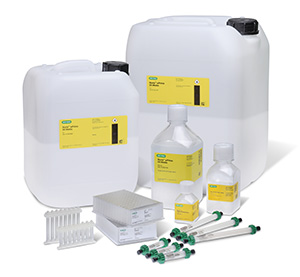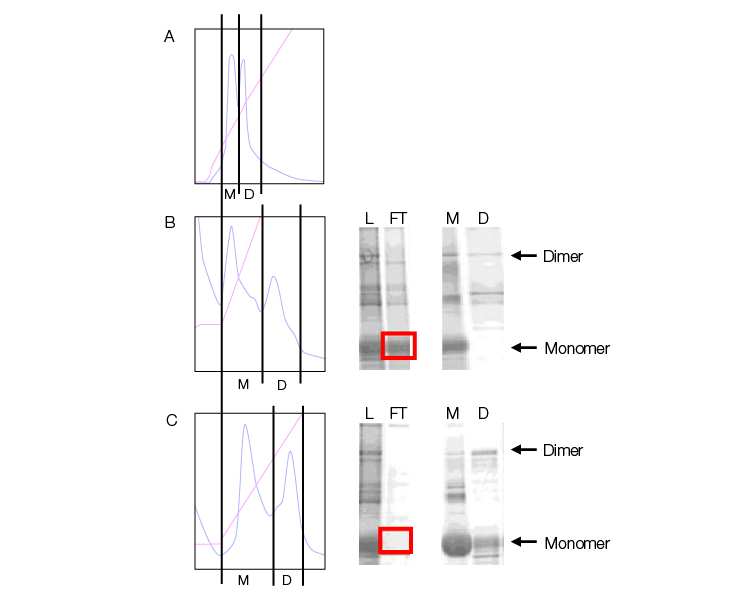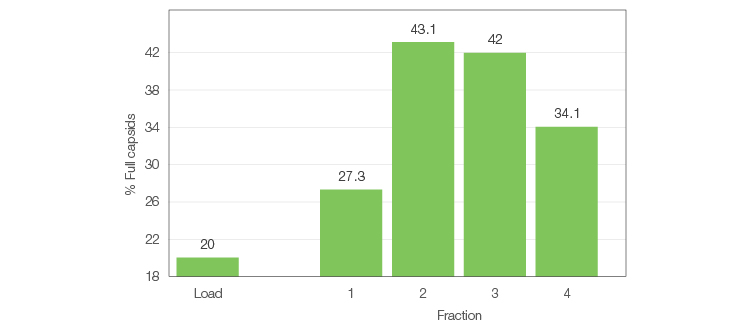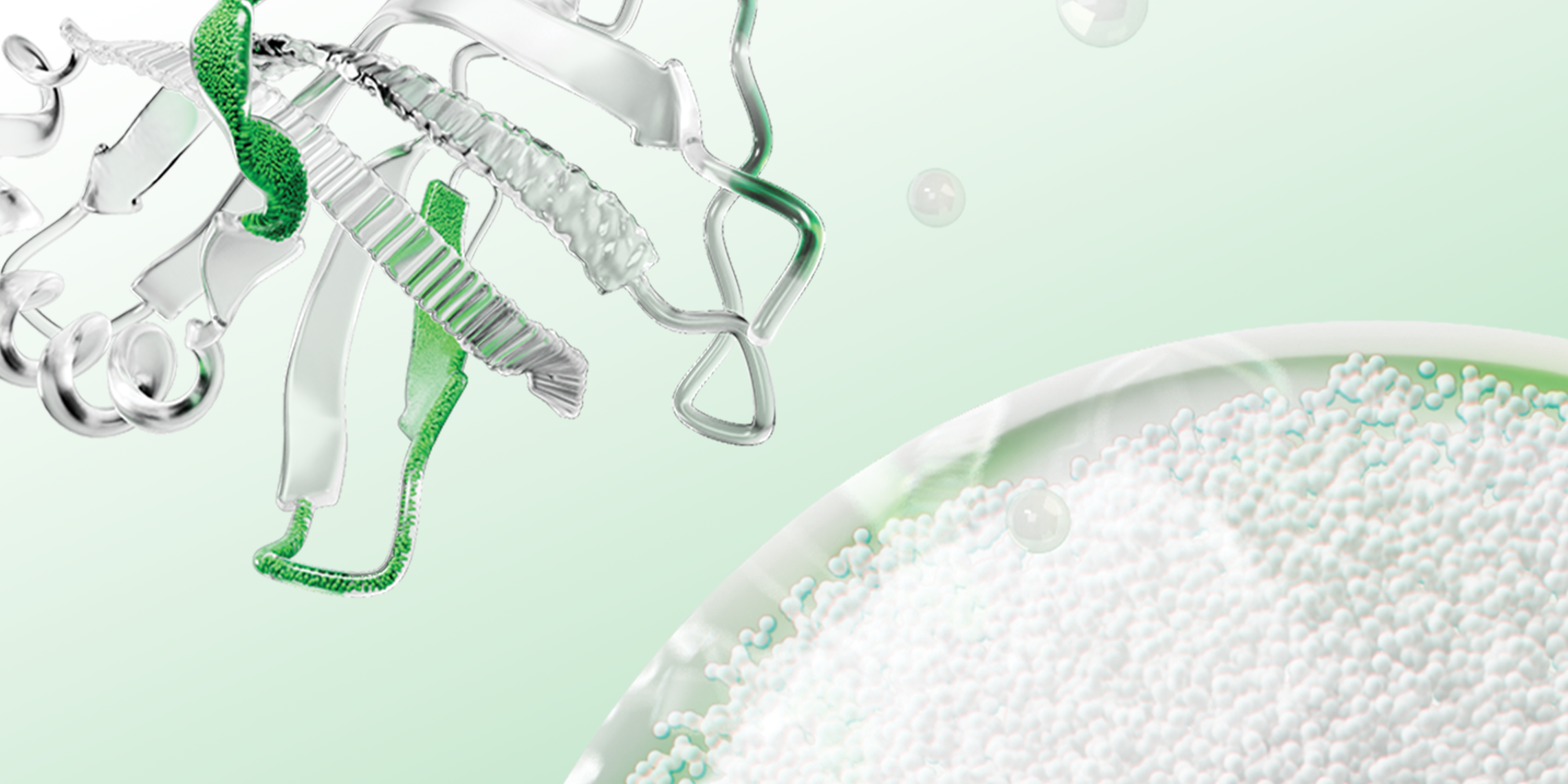A common misconception is that stronger is always better. However, Nuvia wPrime 2A Media, a scalable, weak anion exchange hydrophobic interaction (AEX-HIC) mixed-mode chromatography resin, has won over purification scientists.
When purifying biomolecules, from method development in a laboratory to process-scale operations in manufacturing, you likely want more: higher yields, greater purity, and additional time, space, cost savings, and resources for things other than your downstream workflow. Sometimes, you can enjoy the benefits of more from less.
One Problem with Bind-Elute Workflows
When biomolecules are purified using a chromatographic resin, a common approach is to have the molecule of interest adhere to the resin under one set of conditions (a low concentration of salt, for example) and then disassociate from the resin under different conditions (a high concentration of salt, for example). These so-called bind-elute workflows can capture diverse molecules of interest, but what happens if the target molecule sticks too tightly and will only dissociate under conditions that cause it to aggregate or become insoluble?
Two Reasons to Try Nuvia wPrime 2A Media

Nuvia wPrime 2A Resin is available in both bulk and prepacked 1 ml and 5 ml Foresight Columns, 200 µl and 600 µl Foresight RoboColumns, Foresight Plates, and 1 ml EconoFit Columns.
In such cases, weakness can be a strength. Specifically, chromatography resins that offer a weak ion exchange mode allow for the strength of the resin charge to be tweaked by changing the pH, offering ways to achieve the desired elution. In contrast, strong ion exchangers have the same charge regardless of the pH.
Generally, combining the benefit of a weak ion exchanger with a second interaction mode, such as a hydrophobic interaction, provides an incredible palette of chromatographic options to explore. For instance, to modify the resin’s charge, the pH can be adjusted without changing the salt concentration; the ionic strength can also be altered to affect the resin’s binding capacity, with or without changing the pH. Changing the salt concentration can further influence hydrophobic interactions. Overall, the spectrum of purification conditions that may be analyzed are numerous, facilitating optimization.
While there are many purification conditions that may be explored with such weak AEX-HIC mixed-mode (MM) resins, the number available for laboratory-scale purification has historically been small. Moreover, until recently, the number of these resins suitable for commercial (manufacturing or process-scale) purification was even smaller. Indeed, according to some experts in the field, true options were nonexistent.
Enter Nuvia wPrime 2A Media from Bio-Rad — a genuine game changer, this weak AEX-HIC resin is scalable for manufacturing. The resin is built upon proven Nuvia chromatography technology that has already been incorporated into manufacturing workflows around the world. Nuvia media beads are mechanically stable, allowing the resin to maintain consistent binding capacity at the high flow rates needed for productive manufacturing workflows with favorable process economics. Furthermore, Nuvia resins are chemically stable, allowing them to retain their binding capacity after multiple exposures to sodium hydroxide and other cleaning agents. Technical information and performance data are available in the Nuvia wPrime 2A Media Product Information Sheet.
Three Nuvia wPrime Resin Success Stories
The allure of having a scalable weak AEX-HIC resin with its abundant versatility is undeniable, but can such a resin actually deliver? Over the course of the development of Nuvia wPrime 2A Media, biomanufacturing customers partnered with us to test the resin across a broad spectrum of applications. The following three examples showcase customer successes with Nuvia wPrime 2A resin.
Antibody Purification Success
This comparison was carried out by a leader in protein therapeutics. The researcher compared the ability of Nuvia wPrime 2A Media to purify two monoclonal antibodies (mAbs) and one bispecific antibody (bsAb) to existing processes for each molecule. The results, available in greater detail in a free 15-min webinar, are summarized here.
For the first mAb, an IgG1, the process goal was to decrease the concentration of high molecular weight (HMW) aggregates and reduce the amount of a specific abundant hydrophobic host cell protein (HCP). A secondary goal was to see if the existing polishing process of a strong AEX followed by a strong CEX could be replaced by a single polishing step. By using high-throughput screening (HTS) to explore the vast Nuvia wPrime 2A resin design space, optimal conditions were selected and compared with a single-mode strong AEX resin and process. By using Nuvia wPrime 2A resin, levels of both the HMW species and abundant HCP were reduced, with purity results suggesting that the subsequent CEX column in the process could be removed (Table 1).
Table 1. Comparison of a strong AEX resin with Nuvia wPrime 2A Media.
| Strong AEX Resin | Nuvia wPrime 2A Media (weak AEX MM resin) | |
| Yield | 95% | 95% |
| HMW species | 0.4–0.7% | 0.3% |
| HCP | 9–12 ng/mg | 10 ng/mg |
| Abundant hydrophobic HCP | AEX: Limited reduction (CEX: 10 ng/mg) |
<1 ng/mg |
AEX, anion exchange; CEX, cation exchange; HCP, host cell protein; HMW, high molecular weight; MM, mixed mode.
The second mAb investigated was IgG4, and the process goal was to reduce the HMW species and very high levels of abundant HCP as well as a second enzymatically active HCP. Through a similar optimization approach, use of Nuvia wPrime 2A Media was compared alongside an existing process with a strong AEX-HIC MM resin. Again, Nuvia wPrime 2A resin helped to achieve the desired results (Table 2).
Table 2. Comparison of a strong MM AEX resin with Nuvia wPrime 2A Media.
| Strong AEX MM Resin | Nuvia wPrime 2A Media (weak AEX MM resin) | |
| Yield | 80–90% | 80% |
| HMW species | 0.3–0.5% | 0.2% |
| Abundant hydrophobic HCP | 20–100 ng/mg | <LOQ for all conditions |
| Enzymatically active HCP | 0.05–0.10 mU/mg activity | <0.01 mU/mg for optimal conditions |
AEX, anion exchange; CEX, cation exchange; HCP, host cell protein; HMW, high molecular weight; LOQ, limit of quantitation; MM, mixed mode.
Finally, the process scientist and researcher evaluated the use of Nuvia wPrime 2A Media to increase the yield of a bsAb. Despite trying to operate in flowthrough mode, a significant amount of the bsAb bound to the strong AEX resin in the existing process, resulting in very low yields. By following an approach comparable to those applied to survey the various conditions used for the two mAbs, Nuvia wPrime 2A chromatography resin exhibited reduced product binding and helped to attain more than a twofold improvement in yield versus that of the strong AEX single-mode resin while maintaining similar product quality (Table 3).
Table 3. Comparison of a strong AEX resin with Nuvia wPrime 2A Media.
| Strong AEX Resin | Nuvia wPrime 2A Media (weak AEX MM resin) | |
| Yield | 30% | 75% |
| Product purity | 94% (1% HMW, 5% LMW) | 94% (1% HMW, 5% LMW) |
AEX, anion exchange; HMW, high molecular weight; LMW, low molecular weight; MM, mixed mode.
To learn more about this work, watch the 15-min webcast: Evaluation of a New Multimodal Anion Exchange Resin for Emerging Biotherapeutic Process Challenges.
rProtein Purification Success
In another comparison, a leader in recombinant protein (rProtein) biotherapeutics evaluated the ability of Nuvia wPrime 2A Media to resolve desirable monomers from dimeric impurities and to increase the purity of the monomer target. Using optimized conditions, Nuvia wPrime 2A resin was assessed side by side with an existing strong AEX MM resin–based process, and its binding capacity was also compared to a traditional single-mode diethylaminoethyl (DEAE; weak AEX) resin. The results were shared via personal communication.
Compared to the AEX MM resin-based process (Figure 1A) and to the DEAE-based resin, Nuvia wPrime 2A was better able to resolve the target monomers (Figure 1C), as based on chromatograms. Furthermore, comparison of the SDS-PAGE band intensity between the monomer and dimer fractions showed that Nuvia wPrime 2A chromatography resin more effectively separated the monomers from dimers than the DEAE-based resin.

Fig. 1. Comparison of a strong AEX MM resin versus Nuvia wPrime 2A Media for monomer/dimer separation. rProtein monomer and dimer separation using (A) a strong AEX MM resin, (B) a DEAE-based single-mode IEX resin, and (C) Nuvia wPrime 2A Media at the same flow rate, as revealed by UV280 absorbance (—) and conductivity/salt gradient (—), with the start of the M elution aligned vertically for separation comparison; SDS-PAGE analysis of the DEAE-based and Nuvia wPrime 2A eluates is shown to the right of the respective chromatograms. AEX, anion exchange; D, dimer; DEAE, diethylaminoethyl; FT, flow-through; IEX, ion exchange; L, load; M, monomer; MM, mixed mode.
AAV Purification Success
Last, a leader in adeno-associated virus (AAV) gene therapies determined the ability of Nuvia wPrime 2A Media to separate empty from full capsids (personal communication) with a load containing ~20% full capsids. Optimization resulted in elution fractions containing >43% full capsids (Figure 2). This demonstrates that Nuvia wPrime 2A resin may be used to increase concentrations of gene therapy vectors.

Fig. 2. AAV enrichment by Nuvia wPrime 2A Media. The starting material containing ~20% full capsids was loaded onto the resin in bind-elute mode and washed. After elution, fractions of over 43% full capsids were obtained, showing that the resin is able to enrich full capsids by over twofold. AAV, adeno-associated virus.
One Resin, Infinite Potential
These antibody (monoclonal and bispecific), recombinant protein, and AAV examples are just some of the many ways scientists have used Nuvia wPrime 2A Media to achieve their chromatographic purification goals. We learn of new success stories daily, and our global network of purification scientists are here to help you realize the full potential of your purification workflows.
Nuvia wPrime 2A Media is now available — learn more and request a free sample.



